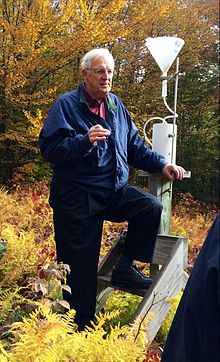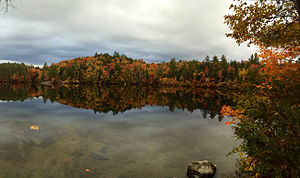Gene Likens
Gene Likens | |
|---|---|
 Gene Likens, 2015 | |
| Born | Gene Elden Likens January 6, 1935 |
| Nationality | American |
| Alma mater | Manchester University University of Wisconsin–Madison |
| Known for | Hubbard Brook Experimental Forest Institute of Ecosystem Studies |
| Spouse | Phyllis Irene Craig Likens (1983–2014) |
| Awards | Royal Swedish Academy of Sciences,Royal Danish Academy of Sciences and Letters,Austrian Academy of Sciences,National Medal of Science,BBVA Foundation Frontiers of Knowledge Award |
| Scientific career | |
| Fields | Ecology |
| Institutions | Dartmouth College,Cornell University,University of Connecticut,University of Uppsala |
Gene Elden Likens(born January 6, 1935) is anAmericanlimnologistandecologist.He co-founded the Hubbard Brook Ecosystem Study at theHubbard Brook Experimental Forestin 1963, and founded theCary Institute of Ecosystem StudiesinMillbrook, New Yorkin 1983.[1]
A leading pioneer in long-term multidisciplinary ecological studies, Likens examines energy flow and biogeochemical flux models in the ecosystems of forests, streams and lakes. Likens is best known for leading the team of scientists that discoveredacid rainin North America, and connected fossil fuels with increasing acidity of precipitation.[1][2]In addition to its scientific impact, this work has influenced public debate and governmental policy, particularly theUnited States Congress'sClean Air Act Amendments of 1990.[3]
Education[edit]
Gene Likens was born inPierceton, Indiana.[4]Likens received his B.S. in zoology atManchester University(North Manchester, Indiana) in 1957,[5]followed by his M.S. in zoology in 1959 from theUniversity of Wisconsin–Madison.[1][6]He received his Ph.D. in zoology in 1962, also from the University of Wisconsin–Madison, for his thesis onTransport of radioisotopes in lakes.[7][8]
Career[edit]
Dartmouth College[edit]
Likens was an instructor and associate professor atDartmouth Collegefrom 1963 to 1969.[1]In the 1960s, Likens did early work in thedry valleysofAntarctica,[9]examining the thermal structures ofLake VandaandLake Bonney.[7]
Hubbard Brook Experimental Forest[edit]


Likens was co-founder in 1963 of a group withF. Herbert Bormann,Robert S. Pierce and Noye M. Johnson working on the Hubbard Brook Ecosystem Study at theHubbard Brook Experimental Forestin theWhite MountainsofNew Hampshire.[10][11]The study immediately found that the rain was abnormally acidic, and the group carried out one of the first scientific studies linking acid rain to air pollution such assulphur dioxidefrom the use offossil fuels.[12][13]
In 1988, Hubbard Brook was designated by theNational Science Foundationas anLTER,a site for collaborative long term ecological research.[3][11][14]In 2005, Hubbard Brook celebrated 50 years of research at the site.[11]Likens' work in the area is considered "one of the world’s most comprehensive studies on how air pollution and land use shape forested watersheds".[3]Work at Mirror Lake, at the lower end of the Hubbard Brook Valley, has been particularly important in understanding the importance of physical, chemical, and biological linkages involving the lake and its watershed and airshed.[15]Liken has extensively studiedbiogeochemical cyclesdescribing the flow of matter within ecosystems.[16]Riparian zoneslinking water and land are particularly important in maintaining the health of wild lands.[17]Liken has also done important work ondeforestationand its potential impact on the chemistry of watersheds. This research has had significant impacts on programs forforest management,in particular theUnited States Forest Service's adoption of a 100–year rotation policy.[2][18]
Likens and others devised a range of highly influentiallong-term experimentson an ecosystemic scale. These include the small-watershed model of nutrient cycling, in which all water entering and leaving a naturally-bounded watershed is measured, enabling scientists to calculate thehydrologic budgetof the watershed.[11]This model has been "extremely influential" in the examination of ecosystems, and is central to the examination of urban ecosystems such as Baltimore.[19]Likens' work is considered "classic",[1][19]and he is credited with establishing a "guiding paradigm" for other ecologists.[1]
Cornell University[edit]
In 1969, Likens joined the faculty ofCornell University.He served as an associate professor from 1969 to 1972, and as a full professor from 1972 to 1983.[1]In addition to being a professor of ecology in the Section of Ecology and Systematics (later named the Department of Ecology & Evolutionary Biology), he served as its acting chairman (1973-1974) and chairman (1982-1983).[20][21]In January 1983 he was named Cornell University's Charles A. Alexander Professor of Biological Sciences. While at Cornell University, he served as chairman of the Section of Ecology and Systematics.[22]
Institute of Ecosystem Studies[edit]
In 1983 Likens founded the (now Cary)Institute of Ecosystem StudiesinMillbrook, New Yorkas part of theNew York Botanical Garden.In 1993, the IES became an independent non-profit with Likens as director and president. Situated at theMary Flagler Cary Arboretum,[1]it is an independent center for ecological research, "whose work is highly relevant to policy concerns."[23]In addition to managing teams of scientists and educators, Likens continued his research at Hubbard Brook each summer.[2]As of 2001, he was appointed to the first endowed chair at the Institute of Ecosystem Studies, the G. Evelyn Hutchinson Chair in Ecology.[1]
In 2007 Likens stepped down as director of the IES and returned to full-time research, currently at theUniversity of Connecticutand as visiting professor at theUniversity of Uppsala,Sweden.In July 2012 he began a three-year term as special adviser to the president of theUniversity of Connecticuton environmental affairs and distinguished research professor.[22]
Likens has published 25 books and more than 580 papers and book chapters.[3]Much of his early work is summarized in U.S. Geological Survey publications.[24]His work has influenced theUnited States Congresson issues such as theClean Air Act Amendments of 1990.[3]
He has been active in a variety of organizations, and has been the vice-president (1975-1976) and president (1976-1977) of the American Society of Limnology and Oceanography; vice-president (1978-1979), president (1981-1982) and honorary Fellow (2012) of the Ecological Society of America; president (2002) of the American Institute of Biological Sciences; and president (2001-2007) of the International Society of Limnology.[20][21]
Awards and honors[edit]
Likens has received a substantial number of awards and honors of various kinds.[20][21]He was elected to theAmerican Academy of Arts and Sciencesin 1979,[6]and theUnited States National Academy of Sciencesin 1981.[1]He was also elected as a foreign member of theRoyal Swedish Academy of Sciencesin 1988, theRoyal Danish Academy of Sciences and Lettersin 1994 and theAustrian Academy of Sciencesin 2000.[20]He became an elected member in biological sciences of theAmerican Philosophical Societyin 2006.[25]He's also a fellow of theAmerican Association for the Advancement of Science.[20]
His awards include the 1988 ECI Prize in Limnetic Ecology,[26]the 1993Tyler Prize for Environmental Achievement[27]and the 2001 Huxley Medal of the Institute of Biology, London, UK.[6]He received a 2001National Medal of Sciencefrom PresidentGeorge W. Bushon June 13, 2002.[1]In 2003, Likens and Dr.F. Herbert Bormannreceived theBlue Planet Prizefrom Asahi Glass Foundation, for "outstanding scientific research that helps to solve global environmental problems".[12]In 2014, he received theAlfred C. Redfield Lifetime Achievement Awardfrom theAssociation for the Sciences of Limnology and Oceanography(ASLO).[3]
He has been awarded honorary doctoral degrees internationally (Universität für Bodenkultur, Vienna, 1992; Wageningen Agricultural University, The Netherlands, 1998) as well as nationally (Manchester College, 1979; Rutgers University, 1985; Plymouth State College, University System of New Hampshire, 1989; Miami University, 1990; Union College, 1991; Marist College, 1993; University of Connecticut, 2004; Montclair State University, 2012).[21]
He has won theBBVA Foundation Frontiers of Knowledge Award(2016) jointly withMarten Schefferfor contributing decisively to what the jury describes as “one of the major challenges” of this scientific discipline: to understand and, where possible, anticipate ecosystem responses to human-induced alterations of the natural environment.
In 2018 Likens was awarded an honorary doctorate from Uppsala University, Sweden.[28]
Family[edit]
Gene Likens and his wife Phyllis Irene Craig Likens (1951–2014) of Clinton Corners, New York have three daughters, Heather, Leslie, and Kathy, and a son, Gregory. Phyllis also worked at Cornell University and the Institute of Ecosystem Studies and contributed significantly to the Hubbard Brook Ecosystem Study. He has seven grandchildren, Sierra, Maxwell, Samuel, Joseph, Noah, Louis, and Jason.[29]
References[edit]
- ^abcdefghijkO'Grady, Richard T. (2002)."AIBS President Gene Likens Awarded National Medal of Science".BioScience.52(6): 459.doi:10.1641/0006-3568(2002)052[0459:apglan]2.0.co;2.
- ^abc"Unit 8: Gene E. Likens".Pearson Education.Archived fromthe originalon March 4, 2016.RetrievedDecember 15,2015.
- ^abcdef"Gene E. Likens receives the Alfred C. Redfield Lifetime Achievement Award".EcoFocus Newsletter.Cary Institute of Ecosystem Studies. May 30, 2014.RetrievedDecember 9,2015.
- ^Jeschke, Jonathan M. (September 25, 2009)."Likens, Gene E."The Encyclopedia of Earth.
- ^"Gene Likens Collection, MC2002/188 and MC2002/188b".Manchester University Archives and Brethren Historical Collection.Funderburg Library, Manchester University, North Manchester, Indiana.RetrievedDecember 9,2015.
- ^abc"GENE E. LIKENS Institute of Ecosystem Studies"(PDF).University of Connecticut.RetrievedDecember 10,2015.
- ^abRagotzkie, Robert A.; Likens, Gene E. (1964). "The heat balance of two Antarctic lakes".Limnology and Oceanography.9(3): 412–425.Bibcode:1964LimOc...9..412R.doi:10.4319/lo.1964.9.3.0412.
- ^Likens, Gene E. (1962).Transport of radioisotopes in lakes (Ph.D. thesis).University of Wisconsin - Madison.
- ^Doran, Peter T.; Lyons, W. Berry; McKnight, Diane M. (2010).Life in Antarctic Deserts and other Cold Dry Environments.Cambridge University Press. p. 1.ISBN9780511718168.RetrievedDecember 14,2015.
- ^"Hubbard Brook Ecosystem Study".National Science Foundation.RetrievedNovember 11,2007.
- ^abcdRains, Michael T. (2005)."Hubbard Brook Experimental Forest Celebrating 50 Years as a Forest Service National Scientific Treasure"(PDF).Forest Science Review.No. 5.RetrievedDecember 14,2015.
- ^ab"IES Director Dr. Gene E. Likens Receives the Blue Planet Prize".LTER Network News.Vol. 16, no. 2. November 16, 2003.RetrievedDecember 9,2015.
- ^"Acid Rain".Cary Institute of Ecosystem Studies.Archived fromthe originalon June 20, 2018.RetrievedDecember 15,2015.
- ^Likens, Gene (October 1, 2013)."The Hubbard Brook Ecosystem Study: Celebrating 50 Years".Bulletin of the Ecological Society of America.94(4): 336–.doi:10.1890/0012-9623-94.4.336.
- ^Winter, Thomas C.; Likens, Gene E. (2009).Mirror Lake: interactions among air, land, and water.Berkeley: University of California Press.ISBN9780520261198.RetrievedDecember 15,2015.
- ^Likens, Gene E.; Buso, Donald C. (2013).Biogeochemistry of a forested ecosystem(3rd ed.). New York: Springer.ISBN978-1461478096.RetrievedDecember 15,2015.
- ^Decamps, H.; Naiman, R.J.; McClain, M.E. (2010)."Riparian zones".In Likens, Gene E. (ed.).River ecosystem ecology: a global perspective: a derivative of Encyclopedia of inland waters.San Diego, CA: Academic Press. pp. 182–189.ISBN9780123819987.RetrievedDecember 15,2015.
- ^CONLEY, DANIEL J.; LIKENS, GENE E.; BUSO, DONALD C.; SACCONE, LOREDANA; BAILEY, SCOTT W.; JOHNSON, CHRIS E. (September 2008)."Deforestation causes increased dissolved silicate losses in the Hubbard Brook Experimental Forest".Global Change Biology.14(11): 2548–2554.Bibcode:2008GCBio..14.2548C.doi:10.1111/j.1365-2486.2008.01667.x.S2CID84326979.RetrievedDecember 15,2015.
- ^abBerkowitz, Alan R.; Nilon, Charles H.; Hollweg, Karen S. (2003).Understanding urban ecosystems a new frontier for science and education.New York: Springer.ISBN978-0387952376.
- ^abcdeJoseph, Heather (2002)."AIBSnews".BioScience.52(7): 627–630.doi:10.1641/0006-3568(2002)052[0627:an]2.0.co;2.
- ^abcd"Gene Likens Ph.D. National Medal of Science - Biological Sciences 2001".Ganga Library Inc.RetrievedDecember 14,2015.
- ^ab"Dr. Gene E. Likens".Cary Institute of Ecosystem Studies.December 15, 2022.
- ^Speth, James Gustave (2004).Global environmental challenges: transitions to a sustainable world.Hyderabad, India: Orient Longman.ISBN8125027408.RetrievedDecember 14,2015.
- ^Wiltshire, Denise A.; Evans, Margaret L. (1984).Acid precipitation; an annotated bibliography U.S. Geological Survey Circular 923(PDF).U.S. Geological Survey.
- ^"Members elected in April 2006"(PDF).News from Philosophical Hall.10(2): 10. 2006. Archived fromthe original(PDF)on March 4, 2016.RetrievedDecember 10,2015.
- ^Likens, Gene E. (1992).THE ECOSYSTEM APPROACH: ITS USE AND ABUSE(PDF).Germany: Ecology Institute.RetrievedDecember 15,2015.
- ^"1993 Tyler Laureates F. Herbert Bormann and Gene E. Likens".Tyler Prize.Archived fromthe originalon July 25, 2017.RetrievedDecember 10,2015.
- ^University, Uppsala (January 24, 2018)."Mini symposium with Honorary Doctor Gene E. Likens".kalendarium.uu.se.RetrievedJuly 23,2021.
- ^"Phyllis Irene Craig Likens Obituary".Ithaca Journal.December 22, 2014.RetrievedDecember 9,2015.
External links[edit]
- "Gene Likens Collection, MC2002/188 and MC2002/188b".Manchester University Archives and Brethren Historical Collection.Funderburg Library, Manchester University, North Manchester, Indiana.
- Wiltshire, Denise A.; Evans, Margaret L. (1984).Acid precipitation; an annotated bibliography U.S. Geological Survey Circular 923(PDF).U.S. Geological Survey.
- American ecologists
- Fellows of the American Academy of Arts and Sciences
- Fellows of the American Association for the Advancement of Science
- Members of the American Philosophical Society
- Members of the Austrian Academy of Sciences
- Members of the Royal Danish Academy of Sciences and Letters
- Members of the Royal Swedish Academy of Sciences
- Members of the United States National Academy of Sciences
- Living people
- 1935 births
- National Medal of Science laureates
- Manchester University (Indiana) alumni
- University of Wisconsin–Madison College of Letters and Science alumni
- Dartmouth College faculty
- Cornell University faculty
- Australia Prize recipients
- Fellows of the Ecological Society of America
- American limnologists
- Presidents of the Association for the Sciences of Limnology and Oceanography
- Benjamin Franklin Medal (Franklin Institute) laureates

